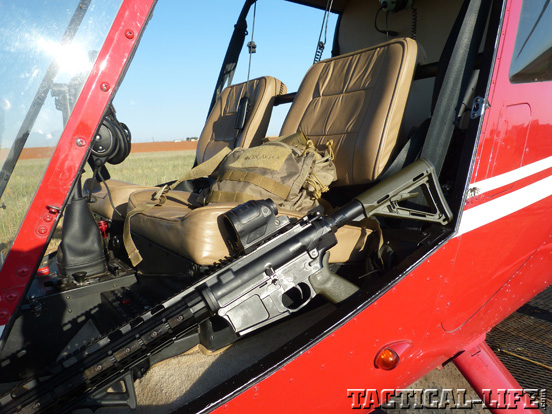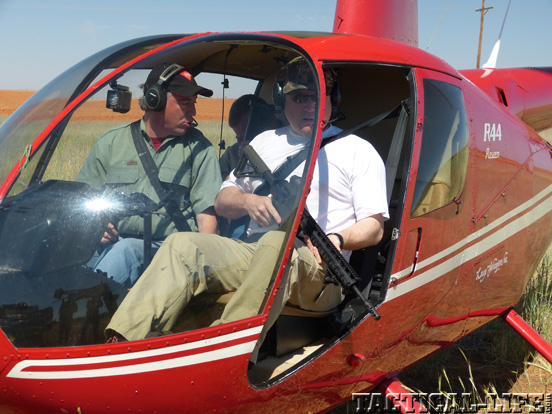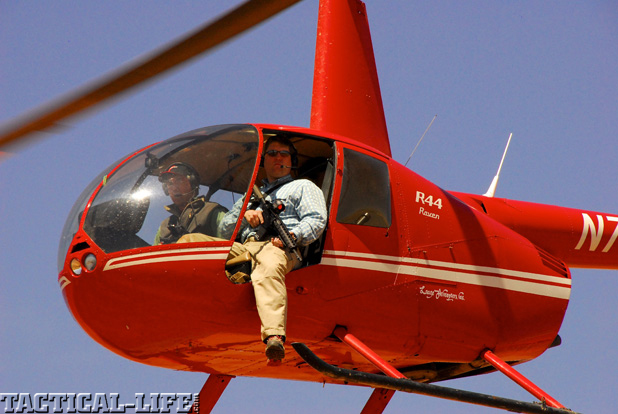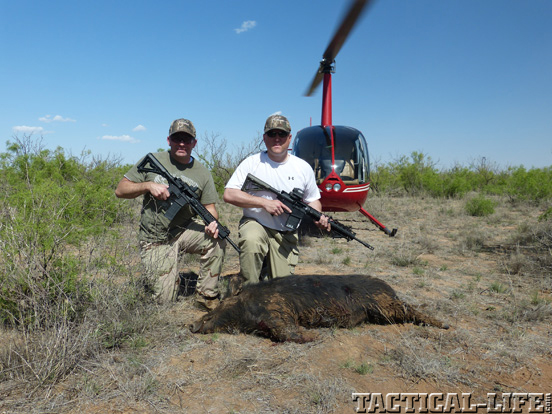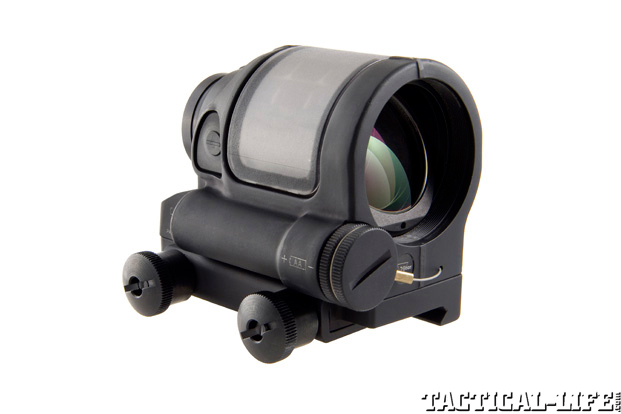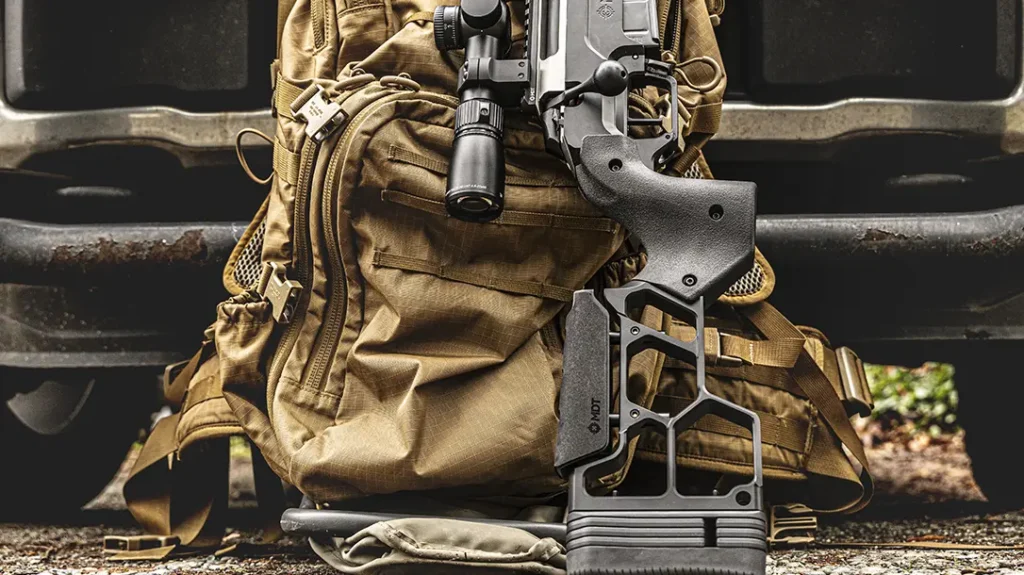Texas has a problem. With gas at $4 per gallon, it’s not oil. The three-year drought has broken and cotton levels are at an all-time high. Her problem is wild hogs. Feral hog populations have reached a critical mass, exploding across the landscape. Near impossible to starve, scare or poison, invasive hogs now number close to two million in Texas. According to Texas A&M University feral hogs are the most prolific large, wild mammal in North America. Given adequate nutrition feral hog populations can double in four months. They have become an absolute danger to both the environment and agriculture, rooting and destroying crops and fragile habitats with damages exceeding $400 million in the state of Texas alone. After a rooting herd of hogs passes by, the place can resemble a World War I “no-man’s land” scene, fully denuded and bereft of life.
State biologists estimate one feral sow living a normal life can account for over four hundred offspring. Moreover, it is estimated that culling 70 percent of the the current population will only stem the tide to a manageable level &mdash much more work lies ahead. Now there are practically no restrictions to hog hunting in Texas. The state requires an :exotic” hunting license, which is cheap, carries no tag limits, and permits hunters to use bows, rifles or shotguns with no magazine restrictions. Yet with all this latitude the problem persists. In many ways, hunters are properly and unfortunately the last resort, and this has lead to the practice of aerial hog eradication. But unlike traditional big-game hunting, the purpose of aerial hog shooting is to remove a destructive, invasive species from the land.
Enter the helicopter eradication specialist turned guide/outfitter. Since September of 2011, Texas has allowed licensed eradication pilots to sell shooter seats on their previously restricted business of nuisance animal control. Now landowners and hunters can fly with contracted pilots to fire down upon hogs.
Advertisement — Continue Reading Below
Aerial Hogging
So what is aerial hog shooting? Is it sporting? Does it work? Kyle Lange, a second-generation helicopter pilot and Texan from San Angelo, believes the regulation change has not only opened up the process to a broader range of shooters but has also raised awareness of the feral hog problem. “It’s slightly more complicated than people think. You need good terrain, dedicated shooters and solid flying. If you want to solve the problem, you can’t just shoot a few hogs just to say you have done it, and go home. Seeing the hogs from the air gives new insight into the magnitude of the problem. There were times where we have hunted the same area year after year and only after the third year of aggressive eradication did we see a drop off in the number of hogs.”
The first and most important factor to a successful aerial shooting is a talented and conscientious pilot. Safety in the air with power lines, trees, wind and two shooters anxious to put shots on multiple zigzagging targets is a great deal to manage. The pilot must balance all these elements along with navigation and the mechanical status of the aircraft. It’s a task for neither an amateur pilot nor a novice shooter. Lange is one of those special pilots blessed (or perhaps cursed) with the ability to manage multiple variables at once and still laugh with—or at—shooters while calling out shots, angles and targets. He makes it look easy, but the fatigue in his face at the end of the day belies the supreme concentration required by the hours of flying.
Lange flies a Robinson R-44 Raven II, a four-seat piston-engine helicopter. It’s red from nose to tail with a high prop and a single tail rotor. Typically two shooters (one in the left-front seat and one in the back) fly with one leg and a rifle out the door. For the shooter the most important piece of gear is the seat belt. The chopper is moving and so are the targets, but the process will come to an immediate and final halt if the shooter exits the aircraft mid-flight. Shooting from the helicopter requires constant adjustment within the constraints of the seat belt and the interior of the aircraft. No two shots are the same, and getting into a stable shooting position is a constant challenge. But when all the factors align it’s the closest a human can come to feeing like a raptor.
Advertisement — Continue Reading Below
Hog Firepower
Rifle and ammunition setups for aerial hog shooting continue to evolve. Several state agencies use shotguns, and methods vary amongst professional eradication shooters. Lange currently runs suppressed AR platforms chambered in 5.56x45mm and 7.62x39mm. He initially designed his own brass deflectors and collection devices to keep the hot brass out of the cockpit. The suppressors also reduce the fatigue on the pilot, particularly from the shooter firing from the backseat. Space is limited in the helicopter. And because of the tight seatbelt, chest and waist rigs are out—we basically flew with our rifles, optics and a bag full of loaded mags. I used a Drago Gear Collapsible Pack that had two large internal pockets to separate empty mags from full ones, but it was still small enough to fit between my feet.
In aerial hog shooting there are no points for hits in different zones nor bonuses for longer range shots—a stealthy or sporting stalk is not part of the process. Your job as an eradication shooter is to humanely eliminate as many hogs as possible in order to restore balance to the environment. So after running a 5.56mm to get accustomed to the feel of the aircraft and the hogs, I decided that Robert Ruark’s adage “use enough gun” applied to aerial hog shooting. Many of the hogs were over 250 pounds and could take multiple 5.56mm hits without slowing. All factors considered, not the least of which was a baseline ability to hit the targets efficiently, the larger .308 rounds were my best choice. Enter the LaRue PredatAR OBR, with a Trijicon SRS optic and Black Hills/Barnes TSX ammunition.
Rifle SeTup
Building on the success of the OBR (optimized battle rifle), LaRue’s PredatAR OBR was created as a lighter and faster version designed primarily for the civilian market. I set up the PredatAR OBR with Trijicon’s new SRS (sealed reflex sight) optic. New to the market in 2012, Trijicon created the SRS to meet market demand for a light, fast non-magnified red-dot optic—for aerial hog applications it was ideal. The optic features a 1.75-MOA adjustable red-dot sight with a 28mm aperture that greatly reduced the lost-in-the-tube effect of many similar optics. Under the Texas sun I set the brightness near its highest level and zeroed to 50 meters. This was an on-site back-of-the-envelope adjustment, but I was looking for a minimal point-of-aim/point-of-impact variance and a bright light that would stand out against the terrain. It’s worth noting that in addition to the three-year battery life the SRS has a solar cell that guarantees operation in daylight conditions if the batteries die.
Advertisement — Continue Reading Below
I was unprepared for the volume of shooting I would encounter. I flew to Texas and, as TSA imposes limits on ammo, rolled in with about 200 rounds of Black Hills 168-grain TSX. The rest of the time I used Russian-made 148-grain soft points. The contrast between the two was stark: the step from the 148-grain Russian ammo to the 168-grain TSX was almost as noticeable as the jump from 5.56mm to 7.62mm. The TSX bullets hit like sledgehammers, rolling even the largest hogs with average shot placement. One additional intangible was the proper functioning within the rifle. Several of the Russian rounds, despite solid primer strikes, failed to fire and others had light powder loads that would not cycle the weapon properly, resulting in double-feed jams. If you want to make a helicopter pilot nervous, raise the muzzle above the horizontal (point towards the rotors) while you are clearing a malfunction. The terminal effects and the safety factor makes the choice of quality ammo a no-brainer under these shooting conditions.
Go Time
Kyle Lange arranged our shoot on the flat plains of northwest Texas, near the city of Brownfield. The landscape is a billiard-table flat patchwork of green crop circles irrigated by pivot rigs, rust-red corduroy squares of cotton and peanut fields, and vast stretches of mesquite scrub. The terrain is interrupted intermittently with jagged scars of water, along which salt cedars and cottonwood grow. The hogs typically congregate around the water, gouging the banks into a ground-beef-like mush of uprooted plants and mud. We catch a few groups in the open, but typically Lange targets the greener thickets and drops in low and loud. Sometimes, small pairs and trios of large boars pop up together. In other places, the first pass of the helicopter produces a covey flush of 30-plus hogs of all sizes. The sheer numbers of these hogs really defies description and must be witnessed first-hand. When you see the environmental devastation that looks as though it could only be caused by a fleet of large industrial machines, you begin to get the picture. When a sounder of 40 hogs scatters in snaking lines across the scrub, the entire picture becomes clear. The hogs are just about everywhere and little stops their progress. But this week, in this place, we will attempt to check it.
These hogs are not the spotted, gone-feral types—neither Arnold from “Green Acres” nor his lookalikes are anywhere near this part of Texas. The hogs are tough, black, often tusked and heavily built. They have huge heads atop massively muscled shoulders and are covered in coarse, wiry hair. Shot placement is key, and shooting this many hogs from above provides a unique education in terminal ballistics. A hit behind the centerline (measured horizontally, a palm’s width down the spine from the shoulder) might as well be a miss, particularly with the smaller caliber rounds. A shot placed in the head does not guarantee success. The hide and skulls on these beasts are such that a round may not penetrate. A shot placed at the back of the skull (actually a large area on a hog) or anywhere on the spine is optimal: a hog hit there goes down immediately and stays down. Shots into the vitals forward the center line are also effective. Again, this isn’t a hunt. The hogs can’t escape the helicopter. The point of the exercise is to as thoroughly and humanely remove as many hogs as possible, so precision is paramount but challenging.
Advertisement — Continue Reading Below
Shooting from a helicopter is an art and imprecise science. A shooter must make split-second calculations for each shot that account for the speed of the chopper, speed and direction of the hog relative to the chopper, the angle of the chopper to the hog, and any variations in the terrain. Lange’s experience was key in schooling us into proper shooters. Early on he would set us up on a shot and remind us that the chopper will be moving faster so we should actually aim behind (lag) the hog to account for the difference. I was shooting with fellow writer Tom Beckstrand, a former U.S. Army Special Forces officer and sniper. We typically switched off between being shooter and spotter. Beckstrand pulled off some incredible quartering shots that I put down to sheer luck, until he repeated equally difficult shots three and four times.
Sundown
Ultimately, we removed a large number of hogs and more than a few coyotes in two-and-a-half days of shooting. In this small corner of Texas there were now fewer hogs to destroy the environment and devour the food the indigenous species could not hope to compete for. But after seeing the sheer numbers of hogs with their individual power and collective destructiveness, it’s clear Texas has a long way to go in solving the problem.

